

Ind. Appl. of Heck Type Rct.
IV.2.1.3 Palladium-Catalyzed Coupling Reactions for Industrial Fine Chemicals Syntheses
MATTHIAS BELLER and ALEXANDER ZAPF
A. INTRODUCTION
Pd-catalyzed coupling processes of C—X compounds (X Cl, Br, I, N2 , COCl, SO2Cl, CO2C(O)R, OSO2Rf, OMs), such as the Heck and Suzuki reactions, the Stille and Sonogashira couplings, and similar carbonylation reactions are well established methods for carbon – carbon bond formation in organic synthesis on a laboratory scale. Due to their generality and broad tolerance of functional groups these methods have been used extensively in natural product synthesis. As an example, the alkenylation of aryl—X derivatives (the Heck reaction)[1]–[8] has been called “one of the true power tools of contemporary organic synthesis.”[9] For a number of currently used industrial fine chemicals the coupling reactions shown in Scheme 1 offer the opportunity of shorter and more selective routes to substituted arene and alkenes compared to classic stoichiometric organic transformations.
Despite the utility of the products available by Pd-catalyzed coupling reactions, until recently relatively few industrial applications have been realized. What are the reasons for this paradox? On the one hand, a number of the reactions shown in Scheme 1 still suffer from low catalyst efficiency. Typically 1–5 mol % of a certain palladium precatalyst is used. Hence, catalyst costs dominate the raw material costs* and only extremely highprice products may be produced by these methods. With the use of relatively large amounts of palladium catalysts it is also difficult to keep the palladium contents in pharmaceutical and agrochemical end products at a tolerably low level. In general, organic chemists ignore the problem of catalyst activity (turnover frequencies), which is important for cost-effective manufacturing. In accordance with Blaser, Pugin, and Spindler,[10] we believe that fine chemical production requires catalyst productivities of ca. 1000 – 10,000 and catalyst activities of 200–500 h 1 in order to be competitive with noncatalytic routes. For bulk chemicals the requirements are significantly higher.
*Using current industrial prices for palladium ($20 per g Pd; February 2000), catalyst costs for a hypothetical organic product with a molecular weight of 200 are $106 per kg of product (TON 100) or $11 per kg of product (TON 1000).
Handbook of Organopalladium Chemistry for Organic Synthesis, Edited by Ei-ichi Negishi ISBN 0-471-31506 © 2002 John Wiley & Sons, Inc.
1209
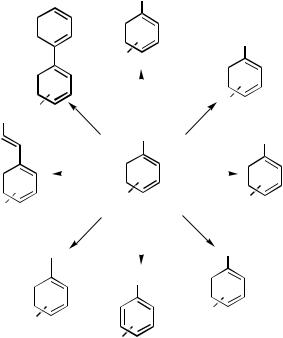
1210 IV Pd-CATALYZED REACTIONS INVOLVING CARBOPALLADATION
|
|
|
|
|
|
|
|
|
CHO |
|
|
|
|
|||
|
|
|
|
|
|
|
|
|
|
|
|
|
|
|
CO2R |
|
|
|
|
|
|
|
|
|
|
|
|
|
|
|
|
||
|
|
|
|
|
|
|
|
|
|
|
|
|
|
|
||
|
|
|
|
|
|
|
|
|
|
|
|
|
||||
|
|
|
|
|
|
|
|
R |
||||||||
|
|
|
|
|
|
|
|
|
|
|
|
|||||
|
|
|
|
|
|
|
|
|
|
|
|
|
|
|
|
|
|
|
|
|
|
|
|
|
|
|
|
|
|
|
|
|
|
|
|
|
|
|
|
|
|
|
|
|
|
|
|
|
|
|
|
|
|
|
|
|
|
|
|
|
|
|
|
R |
|||
|
R |
|
|
|
||||||||||||
|
|
|
|
|
|
|
||||||||||
R |
|
|
|
|
|
|
||||||||||
|
|
|
|
|
|
|
|
|
X |
|
|
|
CN |
|||
|
|
|
|
|
|
|
|
|
|
|
|
|
|
|
|
|
|
|
|
|
|
|
|
|
|
|
|
|
|
|
|
|
|
|
|
|
|
|
|
|
|
|
|
|
|
|
|
|
|
|
|
|
|
|
|
|
|
|
R |
|
|
R |
|||||
|
|
|
|
|
|
|
|
|||||||||
R |
|
|
|
|
||||||||||||
|
|
|
|
R |
|
|
NR2 |
|||||||||
|
|
|
|
|
||||||||||||
|
|
|
|
|
|
|
|
|
|
|
|
|
||||
|
|
|
|
|
|
|
|
|
|
|
|
|
||||
|
|
|
|
|
|
|
|
|
OR |
|
|
|
|
|||
|
|
|
|
|
|
|
|
|
|
|||||||
|
|
|
|
|
|
|
|
|
|
|
|
|
|
|
|
|
|
|
|
|
|
|
|
|
|
|
|
|
|
|
|
|
|
|
|
|
|
|
|
|
|
|
|
|
|
|
|
|
|
|
R
R
R
Scheme 1
Even in the recent past, academic organic synthesis research has paid little attention to the industrial availability and price of starting materials. For example, most university groups developed new catalysts and coupling reactions applying aryl iodides and aryl triflates instead of commercially more interesting aryl chlorides[11]–[13] and anilines.[14]–[20] Hence, only a few of these developments were of significant interest to industry. However, this behavior is changing and currently several university groups worldwide work on the aspects of economical aryl—X activation.
This section tries to give an overview of Pd-catalyzed coupling reactions currently applied in industry. In addition, several reactions are covered, which have been used on a kilogram scale in order to be commercialized. Due to the difficulty of getting information on actual industrial processes, we are not always certain about the real scale of these reactions. However, we believe that other Pd-catalyzed coupling reactions are applied in industry, which are not known to the public. We welcome any information on this topic for future reviews.
B. INDUSTRIAL PROCESSES
One of the first examples of a Pd-catalyzed coupling reaction realized on an industrial scale is the Matsuda–Heck reaction of an aryl diazonium salt with 1,1,1-trifluoropropene developed by Baumeister and co-workers at Ciba-Geigy and today performed on ton scale by Novartis for the synthesis of a sulfonylurea herbicide (Prosulfuron).[21],[22] By combining three synthetic steps (diazotization, alkenylation, and hydrogenation) in a
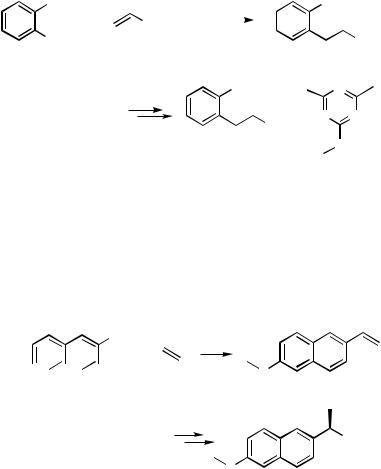
IV.2.1.3 INDUSTRIAL FINE CHEMICALS SYNTHESES BY HECK REACTION |
1211 |
one-pot sequence with an overall yield of 93% (i. e., an average yield of 98% per step), this elegant process was made economically feasible (Scheme 2). Due to the high stability of the in situ generated diazonium salt, safety issues are not a cost-intensive problem in this reaction. Despite diazotization, only 2 kg of wastes per kg of product are produced.
SO3_ |
|
1. Pd(dba)2 |
SO3_ |
|
+ |
CF3 |
|
||
|
|
|
||
2. charcoal |
|
|||
|
||||
N2+ |
|
3. H2 |
CF3 |
|
SO2NHCONH N
N N
CF3
O
Scheme 2
An example of an industrial Heck reaction of an aryl bromide is the announced synthesis of Naproxen by Albermarle.[23] Toward that end, 2-bromo-6-methoxynaphthalene is reacted with ethylene in the presence of a homogeneous palladium catalyst. Apparently, as a ligand a sterically hindered basic phosphine is used.[24] Known Pd-catalyzed hydrocarboxylation of 2-methoxy-6-vinylnaphthalene and subsequent resolution give access to Naproxen (Scheme 3). In addition, it was shown that Ketoprofen can be produced by a similar reaction sequence.
Br
“Pd”/ L
+
 O
O

 O
O
CO2H
O
Scheme 3
The key step—the alkenylation—in the Naproxen process has also been developed with the so-called palladacycle catalyst on a kilogram scale by Hoechst AG and Hoechst-Celanese in 1995. Here, 2-methoxy-6-vinylnaphthalene was obtained in 89% yield at 20 bar ethylene pressure.[25] High catalyst turnover numbers of ca. 10,000 were realized, but due to a shift in the company’s strategy no further development was made.
Similar alkenylations of aryl bromides with ethylene have been used by Dow Chemical to make high-purity 2- and 4-vinyltoluenes, which are of interest as comonomers for styrene polymers (Scheme 4).[26]
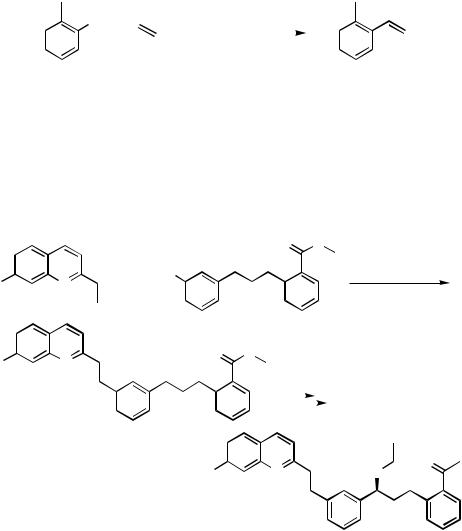
1212 |
IV Pd-CATALYZED REACTIONS INVOLVING CARBOPALLADATION |
|||||
|
|
Br |
+ |
Pd(OAc)2 / P(o-Tol)3 |
||
|
|
|
|
|
|
|
|
|
|
|
|
|
|
Scheme 4
A practical route to a new class of LTD4 receptor antagonists was developed at Merck.[27] An aryl bromide or triflate was coupled with a vinylquinoline (Scheme 5) in DMF at 100 °C utilizing 3 mol % of palladium(II) acetate as precatalyst. In the case of the bromide, tris(o-tolyl)phosphine is the optimum ligand yielding 91% of the desired product. In contrast, using the corresponding triflate as aryl source, triphenylphosphine performed better than tris(o-tolyl)phosphine. Although yields could be further enhanced by addition of lithium bromide only 66% of coupling product was isolated.
|
|
|
|
|
|
|
|
|
|
|
|
|
|
|
O O |
|||
|
|
|
|
|
|
|
X |
O |
||||||||||
|
+ |
|
|
|
|
|
|
|
|
Pd(OAc)2/ L |
||||||||
|
|
|
|
|
|
|||||||||||||
Cl |
N |
|
|
|
|
|
|
|
|
|
|
|
|
|
|
|
|
Et3N, DMF, 100 °C |
|
|
|
|
|
|
|
|
|
|
|
|
|
|
|
|
|||
|
|
|
|
|
|
|
|
|
|
|
|
|
|
|
|
|
|
|
|
|
|
|
|
|
|
|
|
O |
|
|
O |
||||||
|
|
|
|
|
|
|
|
|
|
|
||||||||
|
|
|
|
|
|
|
|
|
|
|
||||||||
|
|
|
|
|
|
|
|
|
|
|
||||||||
Cl |
N |
|
|
|
O |
|
|
|
|
|
|
|
|
|||||
|
|
|
|
|
|
|
|
|
||||||||||
|
|
|
|
|
|
|
|
|
|
|
|
|
|
|
|
|
|
|
|
|
|
|
|
|
|
|
|
|
|
|
|
|
|
|
|
|
|
|
|
|
|
|
|
|
|
|
|
|
|
|
|
|
|
|
|
|
|
|
|
|
|
|
|
|
|
|
|
|
|
|
|
|
|
|
|
 CO2H
CO2H
|
|
|
O |
|
|
||
Cl |
N |
|
S |
|
|||
|
|
|
|
Scheme 5
Other examples for which homogeneously catalyzed Heck reactions have been exploited toward an industrial production include the preparation of the fragrance Lilial developed by Givaudan,[28],[29] the synthesis of the nonsteroidal anti-inflammatory drug Nabumeton by Hoechst-Celanese,[30] and the synthesis of the sunscreen agent 2-ethylhexyl p-methoxy- cinnamate (EHMC) by Hoechst AG * and other companies (Scheme 6). Noteworthy, Nabumeton is obtained in one step via coupling and domino isomerization reaction of 2-bromo-6-methoxynaphthalene with 3-buten-2-ol.[30],[31]
However, to the best of our knowledge, none of these reactions is actually used in industry. Interestingly, 2-ethylhexyl p-methoxycinnamate (EHMC), the most common UV-B sunscreen on the market, was produced for some time by a heterogeneously
*M. Beller, K. Kühlein, and H. Fischer, unpublished results.
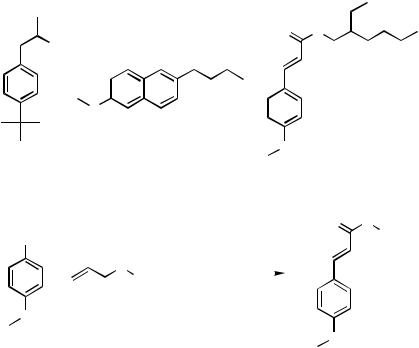
IV.2.1.3 INDUSTRIAL FINE CHEMICALS SYNTHESES BY HECK REACTION |
1213 |
catalyzed Heck reaction by an Israeli chemical company.[32] The IMI process for EHMC involves bromination of anisole and a Heck coupling with 2-ethylhexyl acrylate in N-methylpyrrolidone (NMP) in the presence of Pd/C as a catalyst (Scheme 7). Pilot plant runs were carried out in a 250 L reactor.[33] By using an optimized concentration of starting materials product yields of 80 – 90% were realized after high vacuum distillation. The same technology was used for the synthesis of 2-ethylhexyl p-dimethylaminocinnamate, which has a potential of being a UV-A B filter agent.
|
|
|
|
|
|
|
|
|
|
O O |
CHO |
|
|
|
|
|
O |
||||
|
|
|
|
|
|
|||||
|
|
|
|
|
|
|
|
|
|
|
|
|
|
|
|
|
|
|
|
|
|
|
|
|
|
|
|
|
|
|
|
|
|
O |
|
|
|
|
|
|
|||
|
|
|
|
|
|
|
||||
|
|
|
|
|
|
|
|
|
|
O |
Lilial |
|
|
Nabumeton |
|
|
|
|
|
EHMC |
|
|
|
|
|
|
Scheme 6 |
|||||
|
|
|
|
|
|
|
|
|
|
O O |
Br |
|
|
|
|
|
|
|
|
|
C8H17 |
|
|
|
|
|
|
|
|
|
|
|
|
|
|
|
O |
|
Pd/C, Na2CO3 |
||||
+ |
|
|
|
C8H17 |
|
180−190 °C, NMP |
|
|||
|
|
|
||||||||
O
O
O
Scheme 7
In addition, IMI developed a route to disubstituted benzophenones based on a heterogeneously catalyzed Heck reaction in conjunction with an oxidative cleavage reaction. As an example, the synthesis of 4,4 -difluorobenzophenone, which is used as a monomer for polyether ketones, has been performed by a double Heck reaction of 4-fluorobromoben- zene with 2-ethylhexyl acrylate. Subsequent oxidative cleavage of the double adduct yields the desired product.[34],[35]
The Pd-catalyzed Suzuki reaction[36]–[38] of arylboronic acid derivatives with aryl halides is probably the most powerful method for the construction of an unsymmetrically substituted biaryl derivative (see Sects. III.2.2 and III.2.5). Due to the importance of substituted biaryls as building blocks for pharmaceuticals and new materials, there is currently a great deal of interest in the coupling of economically attractive aryl halides with arylboronic acids.[39]–[52] Industrial realizations of the Suzuki reaction include the production of intermediates for AT II antagonists developed by Hoechst AG and now used by Clariant AG in Frankfurt/Main on a multiton scale (Scheme 8)[53] and of some biaryls at E. Merck KG in Darmstadt (Germany).[54]
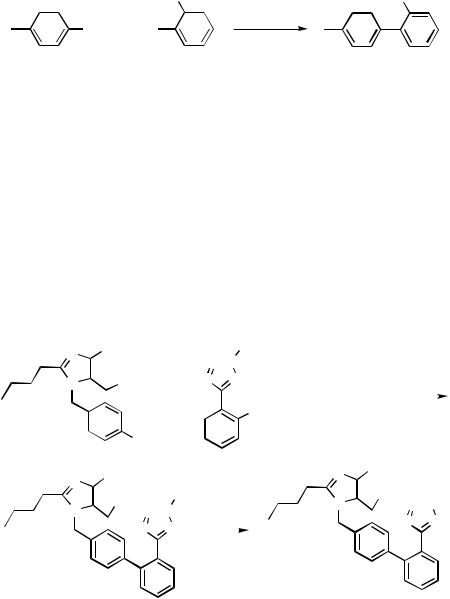
1214 |
IV Pd-CATALYZED REACTIONS INVOLVING CARBOPALLADATION |
|
||||||
|
|
|
|
NC |
NC |
|||
|
|
|
B(OH)2 + |
|
|
“Pd”/ TPPTS |
|
|
|
|
|
|
|
|
|
||
|
|
|
Cl |
|
||||
Scheme 8
2-Cyano-4 -methylbiphenyl is produced by coupling of 4-tolylboronic acid and 2-chlorobenzonitrile in the presence of a palladium/sulfonated triphenylphosphine (TPPTS) catalyst in yields higher than 90%. The reaction is conducted at 120 °C in a polyhydric alcohol solvent (e.g., ethyleneglycol), which contains small amounts of sulfoxide or sulfone for catalyst stability reasons. At the end of the reaction two phases form. The catalyst and salts remain in the polar phase, and the product forms the organic phase. This biphasic procedure allows an efficient recycling of the homogeneous catalyst.
Researchers from Merck elaborated a convergent synthesis for the AT II antagonist Losartan with the key biaryl coupling step in the final stage of the protocol (Scheme 9).[55] The two reaction partners are coupled very efficiently ( 99% yield) utilizing 1 mol% of palladium(II) acetate and 4 mol% triphenylphosphine. As the solvent, a 1:4 mixture of THF and diethoxymethane containing a defined amount of water is crucial for the high reaction rates and yields.
N |
Cl |
|
|
|
|
|
|
CPh3 |
|
|
|
|
|
|
|
|
|
|
|
|
N |
|
N |
|
|
|
|
|
|
|
|
||
|
|
|
|
|
|
|
|
|
|
|
|
|
|
|||
|
OH |
|
|
N |
|
N |
|
|
|
|
|
|
|
|
||
N |
+ |
|
|
Pd(OAc)2 |
/ 4 PPh 3 |
|||||||||||
|
|
|
|
|
|
|
||||||||||
|
|
|
|
|
|
|
|
|
|
|
|
|
|
|
||
|
|
|
|
|
B(OH)2 |
K2CO3, H2O/ THF / DEM |
||||||||||
|
|
|
|
|
|
|
|
|||||||||
|
Br |
|
|
|
|
|
|
|
N |
|
Cl |
|
|
|
|
|
|
|
|
|
|
|
|
|
|
|
|
|
|
|
|||
|
|
|
|
|
|
|
|
|
|
|
|
|
|
|||
|
|
|
|
|
|
|
|
|
|
|
|
|
|
|||
|
|
|
|
|
|
|
|
|
|
|
|
|
|
|||
N |
Cl |
|
|
|
|
|
|
|
|
|
|
|
|
|
||
|
|
|
|
|
|
|
|
|
|
|
|
|
|
|||
OH |
|
CPh3 |
|
|
|
|
|
|
OH |
|
|
|
||||
|
|
|
|
|
|
|
|
|
|
|
||||||
|
|
|
|
|
|
|
|
|
||||||||
|
|
|
|
|
|
|
|
|
|
|
||||||
|
|
|
|
|
|
|
|
|
N |
|
|
N |
|
NH |
||
|
|
|
|
|
|
|
|
|
|
|
||||||
N |
N |
|
N |
H+ |
|
|
|
|
N |
|
N |
|||||
|
N |
|
N |
|
|
|
|
|
|
|
||||||
|
|
|
|
|
|
|
|
|
|
|
|
|
|
|||
Scheme 9
The ecological advantages of a Pd-catalyzed process compared to a process that relies on stoichiometric organic reactions is nicely demonstrated by the Sandoz process for the antifungal Terbinafin.[56] Terbinafin is the active agent of the broad-spectrum antimycotic Lamisil®. It was the first pharmaceutical drug with a 1,3-enyne unit as an integral structural element on the market. The new production process for Terbinafin, which has been awarded with the Sandmeyer Prize of the Swiss Chemical Society, is shown in Scheme 10. An important step is the Pd-catalyzed coupling of a substituted alkenyl chloride with
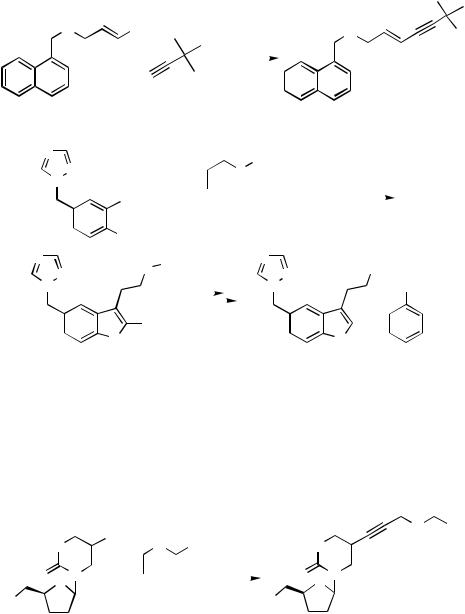
IV.2.1.3 INDUSTRIAL FINE CHEMICALS SYNTHESES BY HECK REACTION |
1215 |
tert-butylacetylene. This coupling reaction proceeds stereoselectively in the presence of less than 0.05 mol % of the precatalyst PdCl2(PPh3)2. As cocatalyst Cu(I)I is added.
A cross-coupling reaction of an o-iodoaniline and an alkyne is a key step in Merck’s synthesis of MK-0462, a 5-HT1D receptor agonist and potential antimigraine drug (Scheme 11). As a catalyst, simple palladium(II) acetate, although in relative high concentrations (2 mol %), is used without any ligand. Under these conditions, 80% of the (partially de-O-protected) substituted indole is formed in DMF at 100 °C.[57]
|
|
|
|
|
|
|
|
|
|
|
|
|
|
|
|
|
|
|
|
|
|
|
|
|
|
|
|
|
|
|
|
|
|
|
|
|
|
|
|
|
|
N |
Cl |
|
|
|
|
|
|
|
|
|
|
|
|
|
N |
|||||
|
|
|
|
|
|
|
|
|
|
|
|
|
|
|
|
|||||
|
|
+ |
|
|
|
|
|
|
|
Pd(PPh3)2Cl2 |
|
|
|
|
|
|
|
|||
|
|
|
|
|
|
|
|
|
|
|
CuI |
|
|
|
|
|
|
|
|
|
|
|
|
|
|
|
|
|
|
|
|
|
|
|
|
|
|
|
|
||
|
|
|
|
|
|
Scheme 10 |
|
|
|
|
|
|
|
|||||||
|
|
|
|
|
|
|
|
|
|
|
|
|
||||||||
N |
|
|
|
|
|
|
|
|
|
|
SiEt3 |
|
|
|
|
|
|
|
||
|
N |
|
|
|
|
|
|
|
|
|
|
|
|
|
|
|
|
|
||
|
|
|
|
|
|
|
|
|
|
|
O |
|
|
|
|
|
|
|
||
N |
|
|
|
|
|
|
|
|
|
|
|
|
|
|
Pd(OAc)2, Na2CO3 |
|||||
|
|
I |
+ |
|
|
|
|
|
|
|
|
|
|
|
|
|||||
|
|
|
|
|
|
|
|
|
|
|
|
|
|
|
|
|
|
|
||
|
|
|
|
|
|
|
|
|
|
|
|
DMF, 100 °C |
||||||||
|
|
|
|
|
|
|
|
|
|
|
|
|
|
|
||||||
|
|
NH2 |
|
|
|
|
|
SiEt3 |
|
|
||||||||||
|
|
|
|
|
|
|
|
|
|
|
|
|
|
|||||||
|
|
|
|
|
|
|
|
|
|
|
|
|
||||||||
|
|
|
|
|
|
|
|
|
|
|
|
|||||||||
|
|
|
|
|
|
|
|
|
|
|
|
|
|
|
|
|
|
|
|
|
N |
|
O SiEt3 |
|
|
|
|
|
|
N |
|
|
|
OH |
|||||||
N |
|
|
|
|
|
|
|
|
|
N |
|
|||||||||
|
|
|
|
|
|
|
|
|
|
|
|
|
|
|
|
|
||||
N |
|
|
|
|
|
|
|
|
|
|
N |
|
|
|
|
|
|
CO2H |
||
|
|
|
|
|
|
|
|
|
|
|
|
|
|
|
|
. |
|
|
|
|
|
|
|
SiEt3 |
|
|
|
|
|
|
|
|
|
|
|
|
|
||||
|
|
|
|
|
|
|
|
|
|
|
|
|
|
|||||||
|
|
|
|
|
|
|
|
|
|
|
|
|
|
|
|
|
|
|||
|
|
N |
|
|
|
|
|
|
|
|
|
|
|
|
|
N |
||||
|
|
H |
|
|
|
|
|
|
|
|
|
|
|
|
|
H |
||||
|
|
|
|
|
|
Scheme 11 |
|
|
|
|
|
|
|
|||||||
Another example of a cross-coupling process with an alkyne, which has been developed in industry, is the reaction of an iodo-substituted dideoxynucleoside with trifluo- roacetyl-protected propargylamine. By using a homogeneous Pd(0)/Cu(I) catalyst in dimethylformamide, smooth coupling is achieved.[58] This reaction has been used for the synthesis of DNA sequencing agents by DuPont (Scheme 12).[29]
|
|
|
|
|
|
|
|
|
|
|
|
|
|
|
|
O |
||||
O |
|
|
|
|
|
|
|
|
|
O |
|
|
|
|
||||||
|
|
|
|
|
|
|
|
|
|
|
||||||||||
|
|
|
|
|
|
|
H |
|
|
|
|
|
|
N CF3 |
||||||
|
|
|
|
|
|
|
|
|
|
|
|
|
||||||||
|
|
|
I |
|
|
|
|
|
|
|
|
|
H |
|||||||
HN |
|
+ |
|
|
N CF3 |
Pd/Cu(I) |
HN |
|
|
|
|
|
|
|
|
|||||
|
|
|
|
|
|
|
|
|
|
|
||||||||||
|
|
|
|
|
|
|
|
|
|
|
|
|
|
|
|
|
|
|||
|
|
|
|
|
|
|
|
|
|
|
|
|
|
|
|
|
|
|||
O O N |
|
|
|
O |
O O |
N |
||||||||||||||
|
|
|
|
|
||||||||||||||||
HO |
|
|
|
|
|
|
|
|
HO |
|
|
|
|
|
|
|
|
|||
Scheme 12
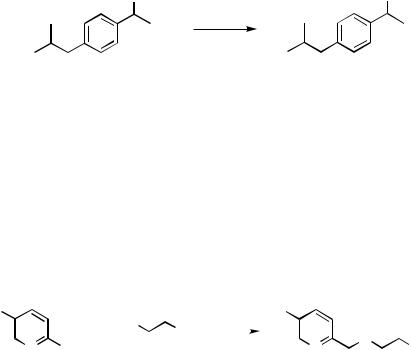
1216 |
IV Pd-CATALYZED REACTIONS INVOLVING CARBOPALLADATION |
Apart from alkenylations and other cross-coupling procedures, carbonylation reactions of aryl and benzyl halides, which make use of the inexpensive reagent carbon monoxide, have attracted industrial interest. (Pd-catalyzed carbonylations are discussed in Sect. VI.2.1 in general.) Simply by changing the nucleophile used in this reaction, acids, esters, amides, aldehydes, ketones, and other compounds are accessible. The synthesis of Ibuprofen, one of the most important nonsteroidal anti-inflammatory agents, developed by Hoechst-Celanese in the late 1980s, demonstrates the synthetic utility of this method. Toward this target, iso-butylbenzene is acetylated in the para position and the resulting acetophenone is reduced to the corresponding benzylic alcohol. Subsequent carbonylation proceeds in concentrated HCl in the presence of a PdCl2/PPh3 catalyst system (Scheme 13).[59],[60] Due to the lower amount of by-products compared to the original Boots process, this catalytic route is now the main industrial production process ( 3000 t/year) for Ibuprofen.
OH |
CO2H |
PdCl2/PPh3
HCl, CO
Scheme 13
Among the carbonylation reactions of aryl halides, those of heteroaryl halides were of special interest to industrial research groups. The attachment of carbonyl functionalities onto heterocyclic frameworks by replacing a halide substituent provides an easy access to valuable intermediates for the manufacture of antifibrotics, herbicides, and other pharmaceuticals. Hence, this type of carbonylation reaction has been used for the production of Lazabemide, a monoamine oxidase B inhibitor, from commercially available 2,5-dichloropyridine. The original eight-step laboratory synthesis of Lazabemide was replaced by a one-step protocol (Scheme 14).[61],[62] The product Lazabemide was isolated in 65% yield. Due to the fact that only small amounts of catalyst have to be used (TON 3000) traces of palladium in the product could be removed by appropriate workup.
Cl |
H2N |
|
Cl |
|
|
|||||
|
+ |
“Pd” |
|
|
|
|
|
H |
||
|
|
|
||||||||
|
NH2 |
|
|
|
|
|
|
|
||
|
|
|
|
|
|
|
|
|||
|
|
CO |
|
N |
||||||
|
N Cl |
|
|
|
|
N |
|
|
|
NH2 · HCl |
|
|
|
|
|
|
|
||||
O
Scheme 14
Another example of a carbonylation of chloropyridines is the synthesis of alkyl 3-chloropicolinates and dialkyl pyridine-2,3-dicarboxylates by Bessard and Roduit at Lonza AG.[63] Starting from 2,3-dichloro-5-(methoxymethyl)pyridine, both the monoand the dicarbonylated pyridine derivatives can be obtained at low CO pressure (15 atm) with high selectivities and yields (Scheme 15). Utilizing PdCl2(PPh3)2 and dppb at 145 °C, 94% of methyl 3-chloropicolinate has been isolated, whereas palladium(II) acetate and dppf at 160 °C leads to a double alkoxycarbonylation reaction.
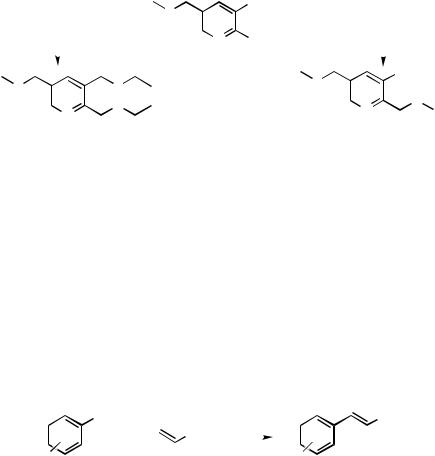
IV.2.1.3 INDUSTRIAL FINE CHEMICALS SYNTHESES BY HECK REACTION |
1217 |
|||||||||||||||
|
|
EtOH, CO |
O |
|
|
Cl |
|
|||||||||
|
|
|
|
|
MeOH, CO |
|
||||||||||
|
|
|||||||||||||||
|
|
|
|
|
|
|
|
|
|
|
||||||
|
|
Pd(OAc)2 |
/dppf |
|
|
N |
|
PdCl2(PPh3)2/dppb |
|
|
||||||
|
|
|
|
|
|
|
|
Cl |
|
|
||||||
|
|
O |
|
|
|
|
|
O |
|
|
Cl |
|
||||
|
|
|
|
|
|
|
|
|
|
|||||||
|
|
|
|
|
|
|
|
|
|
|
|
|
||||
O |
|
|
|
|
O |
|
|
|
|
|
|
|
|
|
O |
|
|
|
|
|
|
|
|
|
|||||||||
|
|
|
|
|
|
|
|
|
|
|
|
|
|
|||
|
|
N |
|
|
O |
|
|
|
|
|
|
N |
|
|
||
|
|
|
|
|
|
|
|
|
|
|
|
|||||
|
|
|
|
|
|
|
|
|
|
|
|
|||||
|
|
|
|
|
|
|
|
|
|
|
|
|
||||
|
|
|
|
|
|
|
|
|
|
|
|
|
|
|
|
|
|
|
|
|
|
|
|
|
|
|
|
|
|
O |
|
||
|
|
O |
|
|
|
|
|
|
|
|
||||||
|
|
|
|
|
|
|
|
|
|
|
|
|
|
|||
|
|
|
|
|
|
Scheme 15 |
|
|
|
|
|
|
|
|
||
C. RECENT DEVELOPMENTS OF INTEREST FOR AN INDUSTRIAL FINE CHEMICALS SYNTHESIS
As stated before, the refinement of economically attractive aryl — X compounds is of general interest in fine chemicals synthesis. In the last decade tremendous progress in the development of new catalysts has been achieved. Since the properties of the central metal palladium can significantly be tuned by ligand variation, the introduction of new ligands was the key to success. This is convincingly demonstrated by the catalyst developments for Heck and Suzuki reactions of aryl chlorides. Tables 1 and 2 present an overview of recent achievements. The Suzuki aryl–aryl coupling reaction is thoroughly discussed in
Sects. III.2.2 and III.2.5.
TABLE 1. Catalyst Development for Pd-Catalyzed Alkenylations of Aryl Chlorides
|
|
Cl |
|
|
|
|
|
catalyst |
|
|
|
R1 |
|
||
|
|
|
+ |
|
R1 |
|
|
|
|
|
|
|
|||
|
|
|
|
|
|
|
|
|
|
|
|
|
|
||
|
|
|
|
|
|
|
|
|
|
|
|
|
|
||
|
R |
|
|
|
|
|
|
|
R |
|
|
|
|||
|
|
|
|
|
|
|
|
|
|
|
|
|
|
|
|
Entry |
Reference |
R |
|
|
R1 |
Catalyst |
|
|
|
Yield (%) |
TON |
||||
|
|
|
|
|
|
|
|
|
|
|
|
|
|
||
1 |
Julia/Kuntz (1973)[64] |
4-CF3 |
|
H |
Pd/C |
|
|
|
62 |
40 |
|||||
2 |
Davison (1984)[66] |
H |
|
|
Ph |
Pd(OAc)2/2 PPh3 |
49 |
25 |
|||||||
3 |
Spencer (1984)[67] |
4-CO2Me |
CN |
Pd(OAc)2/4 PPh3 |
51 |
51 |
|||||||||
4 |
Milstein (1992)[68] |
H |
|
4-C |
H OMe |
Pd(OAc) |
/2 dippb a |
77 |
77 |
||||||
|
Milstein (1993)[69] |
|
|
6 |
|
4 |
|
2 |
|
|
|
|
|
||
5 |
H |
|
|
Ph |
Pd(OAc)2/2 dippp b |
88 |
88 |
||||||||
6 |
Herrmann (1995)[70] |
4-NO |
2 |
CO |
n-Bu |
Pd(dba) /carbene |
99 |
1000 |
|||||||
|
|
|
|
|
2 |
|
|
2 |
|
|
|
|
|
||
7 |
Herrmann/Beller |
4-CF3 |
|
Ph |
Palladacycle c |
|
45 |
45.000 |
|||||||
|
(1995)[71] |
|
|
|
|
|
|
|
|
|
|
|
|
|
|
8 |
Reetz (1998)[72] |
H |
|
|
Ph |
Pd(OAc)2/6 Ph4PCl/ |
65 |
130 |
|||||||
|
|
|
|
|
|
|
|
|
6 DMG d |
|
|
|
|
|
|
9 |
Beller (1998)[31] |
4-CF3 |
|
Ph |
Pd(OAc)2/10 P(OR)3 |
84 |
840 |
||||||||
10 |
Fu (1999)[73] |
H |
|
|
Ph |
Pd2(dba)3/2 P(t-Bu)3 |
80 |
400 |
|||||||
11 |
Hartwig (1999)[74] |
Me |
|
CO |
n-Bu |
Pd(dba) /2 t-Bu |
PFc e |
67 |
27 |
||||||
|
|
|
|
|
|
2 |
|
|
2 |
2 |
|
|
|
||
adippb: 1,4-Bis(di-iso-propylphosphinyl)butane.
bBase free, with Zn; dippp: 1,3-Bis(di-iso-propylphosphinyl)propane.
ctrans-Di( -acetato)-bis[o-(di-o-tolylphosphinyl)benzyl]dipalladium(II).
dN,N-Dimethylglycine.
eDi-tert-butylphosphinylferrocene.

1218 |
IV Pd-CATALYZED REACTIONS INVOLVING CARBOPALLADATION |
|
||||||||
TABLE 2. Catalyst Development for Pd-Catalyzed Suzuki Reactions of Aryl Chlorides |
|
|||||||||
|
|
Cl |
B(OH)2 |
|
catalyst |
|
|
|
|
|
|
|
|
|
|
|
|
||||
|
|
|
|
|
|
|
|
|||
|
|
+ |
|
|
|
|
|
|
||
|
R |
|
|
|
|
|
|
|
|
|
|
|
|
|
R |
|
|
|
|||
|
|
|
|
|
|
|
|
|
||
|
|
|
|
|
|
|
|
|
|
|
Entry |
Reference |
R |
Catalyst |
Yield (%) |
TON |
|||||
|
|
|
|
|
|
|
|
|
|
|
1 |
Beller (1995)[41] |
4-COMe |
Palladacycle a |
82 |
820 |
|||||
2 |
Fu (1998)[48] |
4-Me |
Pd2(dba)3/1.2 P(t-Bu3) |
87 |
29 |
|||||
3 |
Trudell/Nolan (1999)[51] |
4-Me |
Pd2(dba)3/Lb |
96 |
32 |
|||||
4 |
Bei/Guram (1999)[52] |
2-Me |
Pd(dba)2/3 Lc |
95 |
48 |
|||||
5 |
Buchwald (1999)[49] |
4-Me |
Pd(OAc)2/2 Ld |
94 |
1880 |
|||||
6 |
Beller (2000)[65] |
4-CF3 |
Pd(OAc)2/10 P(OR)3 |
88 |
88 |
|||||
atrans-Di( -acetato)-bis[o-(di-o-tolylphosphinyl)benzyl]dipalladium(II).
bN,N1-Dimesitylimidazolium chloride.
c2-(21-Dicyclohexylphosphinylphenyl)-2-methyl-1,3-dioxolane.
d2-(Dicyclohexylphosphinyl)biphenyl.
Milstein and co-workers were the first to introduce catalysts capable of activating various aryl chlorides. By using palladium complexes of highly basic and sterically demanding chelating bisphosphines, for example, dippb [1,4-bis(di-iso-propylphosphinyl)butane], even chlorobenzene has been coupled with alkenes in good to very good yields (70 –95% yield; TON 70 – 95). However, these catalysts are extremely sensitive to air. The introduction of the more robust palladacycles [cyclopalladated complexes of the general formula Pd2( -L)2(P-C)2; L bridging ligand, e.g., OAc, Cl, Br; P-C cyclometallated P-donor, e.g., o-CH2C6H4P(o-Tol)2] as highly active catalysts (TON 40,000 for Heck reactions of 4-chloroacetophenone) by Herrmann, Beller, and co-workers initiated the search for more productive palladium catalysts.
Apart from palladacycles, a number of catalyst systems are currently known that show productivities up to 100,000 for Heck and Suzuki reactions of all kinds of aryl bromides. It is important to note that coupling reactions of electron-deficient aryl bromides (e.g., 4-bromoacetophenone), which are often used in academic laboratories, are not suitable as test reactions to judge the productivity of a new catalyst, because simple palladium salts without any ligand give turnover numbers up to 100,000 with these substrates. Recently, palladium complexes in combination with sterically congested basic phosphines (e.g., tri-tert-butylphosphine), carbenes, and also phosphites[65] led to productive palladium catalysts for the activation of various aryl chlorides.
It is obvious that the development of improved catalysts will continue in the near future. For example, it is believed that new molecularly defined palladium catalysts* will prove to be advantageous to the usually applied in situ generated, undefined catalytically active species.
Apart from the already mentioned Pd-catalyzed coupling reactions it can be predicted that other coupling reactions will be of value to industry in the foreseeable future. Among others, coupling reactions of aryl halides with Grignard reagents, aminations, cyanations,
*M. Gómez Andreu, A. Zapf, and M. Beller, unpublished results.
